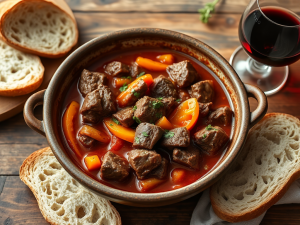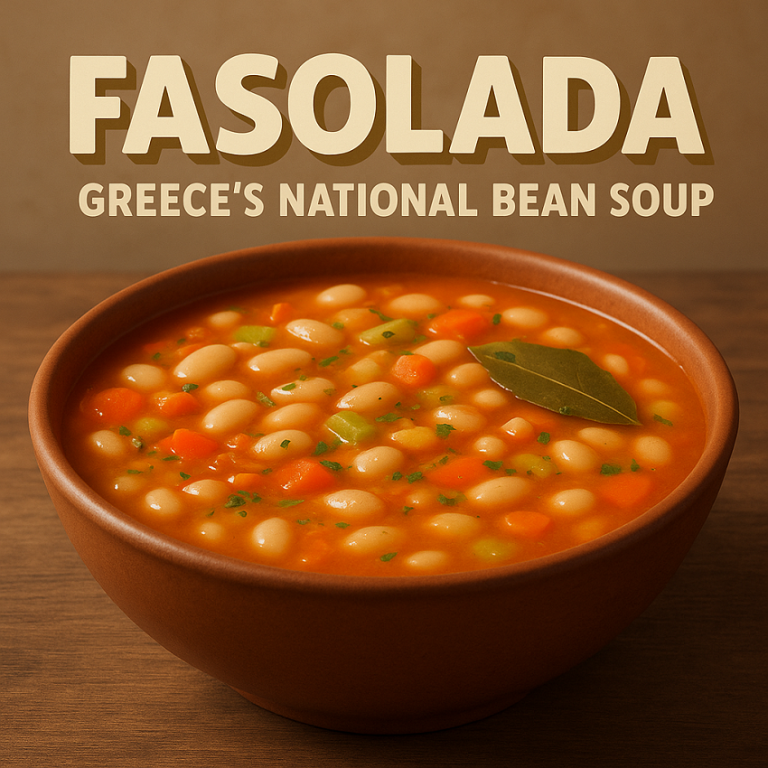
Introduction
Stifado is a traditional Greek stew that embodies the rich flavors and culinary heritage of Greece. Known for its hearty ingredients and aromatic spices, this dish is a favorite among locals and visitors alike. Often enjoyed during family gatherings and festive occasions, stifado is a perfect example of Greek comfort food that warms both the body and soul.
Origins and History
The origins of stifado can be traced back to ancient Greece, where stews were a common way to prepare meat. The word “stifado” itself comes from the Greek word “stifado,” which means “to stew.” Historically, stifado was made with rabbit or beef, reflecting the agricultural practices of the time. As trade expanded and culinary influences mingled, variations emerged, incorporating different types of meat and spices from across the Mediterranean.
In rural communities, stifado was often prepared during the colder months, providing nourishment and warmth. Over time, it became a beloved dish enjoyed not only in households but also in tavernas throughout Greece, where recipes were passed down through generations. Each region of Greece has developed its own unique twist on stifado, showcasing local ingredients and cooking techniques.
Ingredients
The beauty of stifado lies in its simplicity and the quality of its ingredients. A classic stifado recipe typically includes:
- Meat: Beef or rabbit is commonly used, tender and well-marinated. The choice of meat can significantly influence the dish’s flavor profile, with beef providing a rich, robust taste, while rabbit offers a more delicate flavor.
- Onions: Small pearl onions or shallots add sweetness and depth. Their caramelization during cooking enhances the overall richness of the dish.
- Tomatoes: Fresh or canned tomatoes provide a rich base for the stew. The acidity of the tomatoes balances the sweetness of the onions and the spices, creating a harmonious blend.
- Red Wine: Often used for marinating and cooking, red wine adds complexity to the flavor. It not only tenderizes the meat but also infuses it with a deep, earthy richness.
- Spices: Cinnamon, cloves, and bay leaves are essential for that warm, aromatic profile. These spices transport the dish beyond mere sustenance, evoking the essence of Mediterranean cooking.
- Olive Oil: A staple in Greek cuisine, it adds richness to the dish. High-quality extra virgin olive oil enhances the flavors and contributes to the overall texture of the stew.
Preparation
Making stifado is a labor of love, requiring time and care. Here’s a more detailed process:
- Marination: The meat is typically marinated in red wine, olive oil, and spices for several hours or overnight to enhance its flavor. This step is crucial, as it allows the meat to absorb the aromatic notes and become tender.
- Browning the Meat: In a large pot, the marinated meat is browned in olive oil. This step seals in the juices and creates a beautiful caramelized exterior, which adds depth to the final dish.
- Cooking the Onions: The onions are sautéed until golden. Their sweetness develops as they cook, creating a fantastic base for the stew. Once golden, they are combined with the browned meat.
- Adding Tomatoes and Spices: Chopped tomatoes and spices are incorporated, followed by the remaining marinade. This mixture is then brought to a gentle simmer, allowing the flavors to meld beautifully.
- Simmering: The stew is left to simmer slowly for hours, allowing the meat to become tender and the flavors to deepen. This slow cooking process is vital, as it transforms the ingredients into a cohesive and aromatic dish.
 Serving: Stifado is traditionally served with crusty bread, rice, or potatoes, making it a complete meal. The sauce is rich and flavorful, perfect for soaking up with bread or pairing with a side of vegetables.
Serving: Stifado is traditionally served with crusty bread, rice, or potatoes, making it a complete meal. The sauce is rich and flavorful, perfect for soaking up with bread or pairing with a side of vegetables.
Variations
While the classic beef or rabbit stifado remains popular, regional variations abound. In some areas, you might find stifado made with seafood, such as octopus or fish, showcasing the versatility of the dish. Others might incorporate different vegetables like carrots or bell peppers, adding color and nutrition.
Each family often has its own secret twist, making stifado a versatile dish that can be adapted to personal tastes. Some might add a touch of honey for sweetness, while others prefer to amp up the spices for a more robust flavor. This adaptability ensures that stifado remains a beloved staple in Greek kitchens.
Cultural Significance
Stifado is more than just a meal; it represents Greek hospitality and the importance of sharing food with loved ones. It is often served during celebrations, holidays, and gatherings, symbolizing warmth and community. The dish has established itself as a centerpiece at many Greek tables, embodying the spirit of togetherness.
In addition, stifado reflects the agricultural and culinary traditions of Greece, highlighting the importance of local ingredients and seasonal cooking. It serves as a reminder of the deep connection between food, culture, and identity in Greek society.
Conclusion
Stifado is a delightful representation of Greek cuisine, combining simple ingredients into a rich and flavorful dish. Whether enjoyed at a family meal or a festive occasion, stifado brings people together, making it a cherished part of Greece’s culinary heritage. If you haven’t tried this hearty stew yet, it’s definitely worth a taste! With its aromatic spices and comforting flavors, stifado promises to warm your heart and satisfy your palate, offering a true taste of Greece in every bite.



